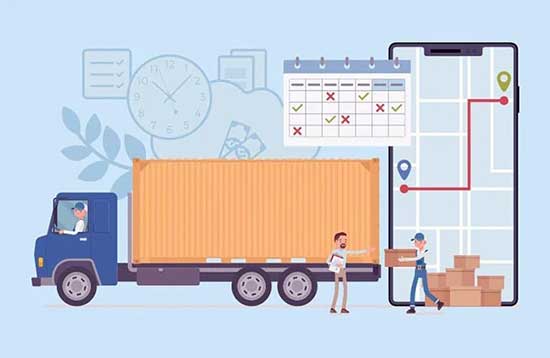

The holiday season presents a unique opportunity for eCommerce businesses to experience a surge in demand. However, this growth potential can quickly become a challenge if businesses remain unprepared to meet customer expectations. The spike in demand could lead to logistics challenges such as increased order volume, warehouse space and labor shortages, and transportation delays, hindering fulfillment efforts. Businesses must invest in robust logistics software like warehouse management systems (WMS) and transportation management systems (TMS) to ensure efficient order processing and delivery to meet the increase in demand and capitalize on the upcoming holiday season.
Like the eCommerce businesses, 3PL providers must also prepare for the holiday season to handle larger volumes and ensure timely deliveries. This first blog of a two-part series will mostly focus on identifying the challenges and optimizing warehouse performance to help increase customer satisfaction and build trust.
By optimizing warehouse space using WMS software and investing in additional resources, 3PLs can effectively manage increased workloads. Proactive planning and contingency measures can help mitigate potential disruptions and ensure a smooth flow of goods, meeting customer expectations and maintaining business efficiency. However, before planning, it’s important to revisit past performance during this period to identify pain points and the scope of improvements.
Review of Past Performance
Logistics software seamlessly analyses historic data, helping businesses uncover recurring challenges like insufficient inventory, delayed shipments, or overwhelmed transportation capacity. By addressing the pain points in advance through advanced logistics ERP, businesses can improve customer satisfaction, reduce costs, and enhance their operational efficiency.
Evaluating the following key metrics can help businesses review past performances and identify challenges.
Fulfillment Speed:
It measures the efficiency of order processing and shipping. Logistics software helps analyze past data, reveal trends in order turnaround times, and identify bottlenecks in order processing, inventory management, and shipping operations.
Delivery Accuracy:
Assessing the accuracy of deliveries helps understand how satisfied customers were in the last season. Tracking metrics like on-time delivery rates, incorrect item deliveries, incorrect addresses, missing items, and damaged goods with the help of logistics software can identify areas for improvement.
Order Returns:
Logistics software helps analyze return rates and provides insights into product quality, customer satisfaction, and the effectiveness of the logistics partner and the returns process. High return rates may indicate issues with product descriptions, sizing, packaging, delivery of incorrect products, product handling by transporters, etc.
Customer Feedback:
Collecting and analyzing customer feedback through surveys, reviews, and social media posts can provide valuable insights. It can help identify specific pain points in the logistics process, such as long wait times, poor communication, packaging issues, or damaged products. Logistics software can track these metrics over time to help businesses identify trends, evaluate progress, make informed decisions, and optimize their operations.
Forecasting and Capacity Planning
Accurate forecasting is important for predicting demand surges and inventory needs during holiday seasons. By analyzing historical data and market trends, 3PLs can anticipate peak periods and ensure sufficient inventory to meet customer demand, avoiding stockouts or excess inventory. While analyzing historical data, 3PLs should also collaborate with eCommerce partners. It helps them gain valuable insights into sales forecasts, product popularity, and promotional campaigns and predict order volumes and stock requirements more precisely.
Now that 3PL providers have the required data to plan their operations and stock levels, they should assess their capacity using WMS software to meet the increased demand.
To accommodate the peak period, 3PLs should:
- Evaluate warehouse space: Warehouse Management Systems enables assessment of current capacity and potential expansion needs to handle increased inventory.
- Analyze staff requirements and engage employees: Measure current staff and estimate whether more manpower will be needed for order processing, shipping, etc., during peak time. Engage and motivate employees to make them perform their best. Happy employees are more productive and productive employees improve warehouse efficiency.
- Review vehicle fleet: Evaluate the current fleet size and utilization rates through TMS software and consider renting or leasing additional vehicles to meet increased demand.
- Review returns and claims: Damaged or lost shipments can affect operational efficiency. Claims or returns essentially mean the order has to be re-processed. It takes away warehouse space that was not planned for and leads to lower customer confidence.
- Implement peak season planning: Develop a detailed plan outlining staffing schedules, inventory management strategies, and transportation routes.
3PL providers need to be flexible when it comes to hiring seasonal workforce, implementing temporary workforce solutions, or renting/leasing additional vehicles, especially during peak periods like the holiday season. It enables efficient resource allocation, scaling operations, and gaining optimal performance and customer satisfaction, without spending much.
Inventory Management and Optimization
Proper inventory management is essential to ensure optimum stock level and eliminate delays or confusion. Here are a few ways to manage and optimize inventory levels:
-
Implement Logistics software
Implement logistics software to ensure stock availability and prevent stockouts during peak demand. By automating inventory, order fulfillment, and supply chain processes, logistics software offers real-time stock visibility, enabling proactive replenishment and reducing manual errors in billing, shipping, etc. They also enhance communication and warehouse operations, improving transparency and customer satisfaction.
-
Use Demand Forecast Tools
WMS software helps predict customer demand and replenish warehouses efficiently. Tools like Just-In-Time (JIT) Inventory Management track real-time demand, prevent excess stock and optimize inventory based on historical data. This approach helps businesses balance supply and demand, reduce waste, and minimize holding costs.
-
Manage Safety Stock and Replenishment Cycles
Implementing a robust safety stock management strategy helps prevent delays and stockouts. Maintaining optimal safety stock levels and adjusting replenishment cycles based on demand and lead times helps mitigate the impact of unexpected demand fluctuations, balance customer needs, and minimize inventory costs. Buffer and anticipatory stock strategies ensure product availability during peak periods, minimizing stockouts and improving customer satisfaction.
-
Employ mobile technologies and technologies to gain real-time stock visibility
Mobile technologies and WMS software provide real-time stock visibility, automate warehouse operations, and reduce manual errors. Warehouse Management Systems and Inventory Management Tools equipped with mobile capabilities track inventory from receiving to picking and packing, ensuring accurate data flow, seamless communication, and streamlined processes. This helps avoid stockouts, overstocking, and double entries while maintaining up-to-date inventory records.
-
Use data analytics
Leveraging data analytics through robust WMS software helps gain valuable insights into inventory levels, warehouse space, customer buying behavior, and market trends. This enables businesses to optimize inventory management, reduce costs and product recalls, enhance customer service with accurate product data, minimize inventory investment, unlock cash flow, and predict optimal stock for future demand. In turn, businesses can make informed decisions to ensure stock availability and prevent stockouts.
WMS software integrated with automation and robotics streamline inventory management by improving picking, packing, and sorting processes. Automated picking systems, voice-directed picking, automated packing stations, automated labeling systems, and automated sorting systems enhance efficiency, accuracy, and scalability while reducing labor costs and errors. These technologies boost productivity through faster, error-free operations, improving customer satisfaction, safety, and long-term cost savings.
Enhancing Warehouse and Fulfillment Center Efficiency
Once you have the inventory stock level sorted, you need enough space and efficient processes to store them and fast-track their picking and packaging. Below are a few such ways to enhance your warehouse space utilization.
Streamlining Warehouse Layouts
-
Optimized Product Placement:
WMS software allows the strategic placement of products based on popularity and order frequency, minimizing pickers' travel distances. By implementing inventory management techniques like ABC analysis and FSN analysis, businesses can prioritize inventory. The product pairing method and demand-based replenishment method simplify picking processes and save time and effort. -
Dedicated Zones:
Creating specific zones for different product categories or order types streamlines picking and packing processes. A WMS software feature, zone-picking strategies also show the fastest route, and which zone the product is stored. -
Clear Signage and Labeling:
Clear signage and labeling guide workers and minimize confusion. Integrating pick-to-light systems, voice-directed picking, and mobile scanning devices and smart wearables into WMS software enables effective product picking.
Utilizing Cross-Docking and Optimized Space Utilization
-
Cross-Docking:
This method of warehouse management systems directly transfers incoming shipments to outgoing orders, reducing handling and storage costs. Cross-docking significantly reduces storage time and frees up valuable warehouse space. -
Vertical Storage:
Vertical storage solutions like racking, cantilever racking, and shelving help maximize space utilization and increase storage capacity by using the height of the building, without expanding the footprint. -
Mezzanine Floors:
After assessing the space need through WMS software, mezzanine floors allow the creation of additional storage space within an existing warehouse by constructing intermediate levels. This maximizes vertical space utilization without the need to expand the building. -
Lean Inventory Practices:
Implementing lean inventory practices with the help of advanced logistics software reduces excess stock and optimizes space usage.
Automation Technologies
-
Automated Guided Vehicles (AGVs):
Integrating AGVs with WMS software helps transport products throughout the warehouse, reducing manual labor and improving efficiency. -
Conveyor Systems:
Conveyor systems automate product movement between different workstations, speeding up processes and reducing errors. -
Automated Packing Stations:
Equipping packing stations with automated technologies like robotic arms and tracking them via WMS software helps streamline packaging processes and improve accuracy. -
Automated Storage and Retrieval Systems (AS/RS):
AS/RS solutions automate the storage and retrieval of goods. They use robotic arms or cranes to move pallets or individual items between storage locations and picking stations. By automating these processes, warehouses can handle higher volumes with greater speed and accuracy. -
Warehouse Management Systems (WMS):
A WMS software integrated with advanced technologies enables businesses to meet the growing demand, optimize inventory management, track product movement, and improve overall warehouse operational efficiency. -
Internet of Things (IoT):
Tracking inventory and space management in real-time by using sensors and RFID tags integrated with WMS software helps gain precise visibility of product locations and quantities. This data drives efficient space allocation, reduces search times, and prevents overstocking.
By implementing these strategies, warehouses and fulfillment centers can significantly enhance their efficiency, reduce costs, and improve customer satisfaction.
As eCommerce businesses and 3PL providers gear up for the holiday season, proactive planning and the adoption of advanced logistics software like TMS and WMS software are crucial. By optimizing warehouse space, improving inventory management, and leveraging automation, businesses can effectively handle the surge in demand, ensuring smooth operations and elevated customer satisfaction.
In the next blog, we will discuss how 3PLs and eCommerce centers can optimize shipping, product delivery, routes, and returns using TMS software. We will also find out how technology helps improve communication between the parties involved and serve the customer better.
Frequently Asked Questions (FAQs)
Enterprise asset management (EAM) involves the management of mission critical assets of an organization throughout each asset's lifecycle. EAM is used to plan, optimize, execute, and track the needed maintenance activities with the associated priorities, skills, materials, tools, and information. The aim is to optimize the quality and utilization of assets throughout their lifecycle, increase productive uptime and reduce operational costs.
Enterprise asset management (EAM) involves the management of the maintenance of physical assets of an organization throughout each asset's lifecycle. EAM is used to plan, optimize, execute, and track the needed maintenance activities with the associated priorities, skills, materials, tools, and information.
The software helps in effective maintenance of assets through preventive, predictive, shutdown and breakdown maintenance strategies. The system also helps enterprises mitigate equipment risks by enhanced safety standards. The streamlined operations and improved asset performance helps organizations increase their investment effectiveness.
EAM is important because it helps organizations track, assess, manage and optimize asset quality and reliability. Asset intensive Organizations have hundreds, thousands, even millions of assets which needs to be maintained to maximize / optimize life of these assets to increase the return on investment.
The key features of effective EAM are:
- Work management.
- Maintenance Strategies (Preventive/ Predictive / Breakdown / Shutdown).
- Planning and scheduling.
- Supply chain management.
- Health and safety.
- Mobility.
- Analytics.
- Improved Asset Health at reduced cost through data driven maintenance Programs
- Complete visibilityon entire maintenance data across Equipment, across Models, across Branches to aid in analysis & decision making such as to Repair or Replace the Equipment
- Insightful analysis of Inspection Data to improve customer satisfaction
- Effective maintenance management enhanced by predictive maintenance and inbuilt analytics
- Increased reliability and safety, keeps complete track of all the inspections & calibration schedules
- Mobile Application enables users to execute work while “in the field” leading to minimized non-productive time and increased productivity and reduces duplication of work and human errors in recording information.
- Quick turnaround time through Actionable Notification & Alerts for every process in real time and accessible anytime and anywhere.
- Improved Regulatory Part of asset management involves the implementation of better O&M practices, which can significantly improve compliance.
Asset Intensive companies under the following Industries :
- Ports
- Cement and Mining
- Utilities
- Fleet Maintenance
- Equipment Rental
- Other Manufacturing
- Real Estate & Infrastructure
- Power Generation
Contact us for a meeting and schedule a demo
This differs on case to case basis, based on the type of installation and unique industry specific requirements. Contact us for a meeting and schedule a demo.
This differs on case to case basis, based on the type of installation and unique industry specific requirements. Contact us for a meeting and schedule a demo.
Stay Connected, follow us on LinkedIn / Twitter to know more about EAM Software latest trends.


